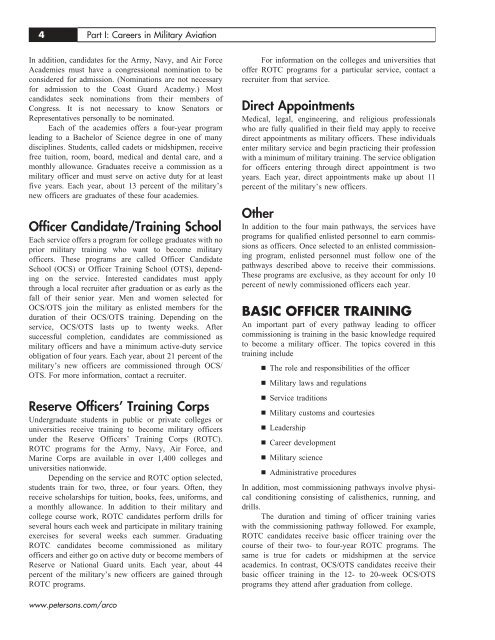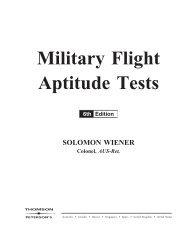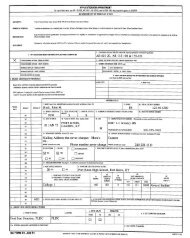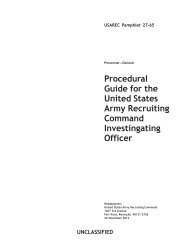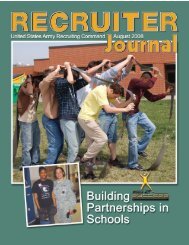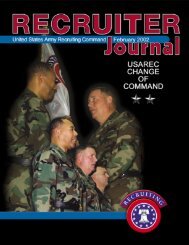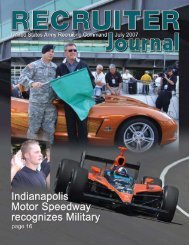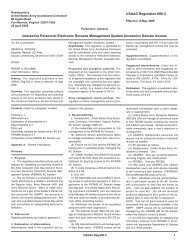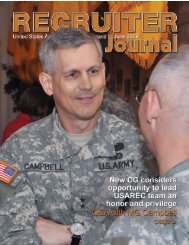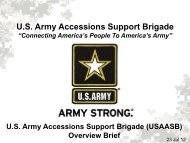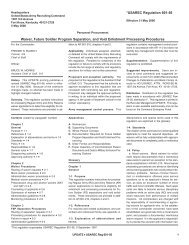Military Flight Aptitude Tests - USAREC - U.S. Army
Military Flight Aptitude Tests - USAREC - U.S. Army
Military Flight Aptitude Tests - USAREC - U.S. Army
You also want an ePaper? Increase the reach of your titles
YUMPU automatically turns print PDFs into web optimized ePapers that Google loves.
4 Part I: Careers in <strong>Military</strong> Aviation<br />
In addition, candidates for the <strong>Army</strong>, Navy, and Air Force<br />
Academies must have a congressional nomination to be<br />
considered for admission. (Nominations are not necessary<br />
for admission to the Coast Guard Academy.) Most<br />
candidates seek nominations from their members of<br />
Congress. It is not necessary to know Senators or<br />
Representatives personally to be nominated.<br />
Each of the academies offers a four-year program<br />
leading to a Bachelor of Science degree in one of many<br />
disciplines. Students, called cadets or midshipmen, receive<br />
free tuition, room, board, medical and dental care, and a<br />
monthly allowance. Graduates receive a commission as a<br />
military officer and must serve on active duty for at least<br />
five years. Each year, about 13 percent of the military’s<br />
new officers are graduates of these four academies.<br />
Officer Candidate/Training School<br />
Each service offers a program for college graduates with no<br />
prior military training who want to become military<br />
officers. These programs are called Officer Candidate<br />
School (OCS) or Officer Training School (OTS), depending<br />
on the service. Interested candidates must apply<br />
through a local recruiter after graduation or as early as the<br />
fall of their senior year. Men and women selected for<br />
OCS/OTS join the military as enlisted members for the<br />
duration of their OCS/OTS training. Depending on the<br />
service, OCS/OTS lasts up to twenty weeks. After<br />
successful completion, candidates are commissioned as<br />
military officers and have a minimum active-duty service<br />
obligation of four years. Each year, about 21 percent of the<br />
military’s new officers are commissioned through OCS/<br />
OTS. For more information, contact a recruiter.<br />
Reserve Officers’ Training Corps<br />
Undergraduate students in public or private colleges or<br />
universities receive training to become military officers<br />
under the Reserve Officers’ Training Corps (ROTC).<br />
ROTC programs for the <strong>Army</strong>, Navy, Air Force, and<br />
Marine Corps are available in over 1,400 colleges and<br />
universities nationwide.<br />
Depending on the service and ROTC option selected,<br />
students train for two, three, or four years. Often, they<br />
receive scholarships for tuition, books, fees, uniforms, and<br />
a monthly allowance. In addition to their military and<br />
college course work, ROTC candidates perform drills for<br />
several hours each week and participate in military training<br />
exercises for several weeks each summer. Graduating<br />
ROTC candidates become commissioned as military<br />
officers and either go on active duty or become members of<br />
Reserve or National Guard units. Each year, about 44<br />
percent of the military’s new officers are gained through<br />
ROTC programs.<br />
www.petersons.com/arco<br />
For information on the colleges and universities that<br />
offer ROTC programs for a particular service, contact a<br />
recruiter from that service.<br />
Direct Appointments<br />
Medical, legal, engineering, and religious professionals<br />
who are fully qualified in their field may apply to receive<br />
direct appointments as military officers. These individuals<br />
enter military service and begin practicing their profession<br />
with a minimum of military training. The service obligation<br />
for officers entering through direct appointment is two<br />
years. Each year, direct appointments make up about 11<br />
percent of the military’s new officers.<br />
Other<br />
In addition to the four main pathways, the services have<br />
programs for qualified enlisted personnel to earn commissions<br />
as officers. Once selected to an enlisted commissioning<br />
program, enlisted personnel must follow one of the<br />
pathways described above to receive their commissions.<br />
These programs are exclusive, as they account for only 10<br />
percent of newly commissioned officers each year.<br />
BASIC OFFICER TRAINING<br />
An important part of every pathway leading to officer<br />
commissioning is training in the basic knowledge required<br />
to become a military officer. The topics covered in this<br />
training include<br />
n The role and responsibilities of the officer<br />
n <strong>Military</strong> laws and regulations<br />
n Service traditions<br />
n <strong>Military</strong> customs and courtesies<br />
n Leadership<br />
n Career development<br />
n <strong>Military</strong> science<br />
n Administrative procedures<br />
In addition, most commissioning pathways involve physical<br />
conditioning consisting of calisthenics, running, and<br />
drills.<br />
The duration and timing of officer training varies<br />
with the commissioning pathway followed. For example,<br />
ROTC candidates receive basic officer training over the<br />
course of their two- to four-year ROTC programs. The<br />
same is true for cadets or midshipmen at the service<br />
academics. In contrast, OCS/OTS candidates receive their<br />
basic officer training in the 12- to 20-week OCS/OTS<br />
programs they attend after graduation from college.


